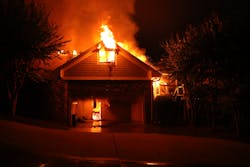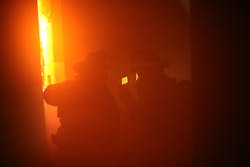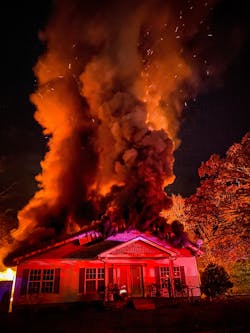The Next Generation of Search Based on Today’s Data
Each year, more than 75 percent of all civilian fire fatalities occur as a result of fires in homes, and in today’s modern environment, time for escape is reduced significantly. According to the U.S. Fire Administration (USFA) and the most recent data, the most notable factors that contributed to fatalities were fire pattern (61 percent), egress problems (22 percent) and escape problems (17 percent). Fire pattern factors involve situations in which exits are blocked by smoke and flame, vision is blocked or impaired by smoke, and civilians are trapped above or below the fire. Egress problems include crowded situations, limited exits, locked exits or other exit problems, as well as mechanical obstacles to the exit. Escape problems include unfamiliarity with exits, excessive travel distance to the nearest clear exit, inappropriate exit routes, reentering the building and clothing catching on fire while escaping.
What do data such as these mean for your search effort? How can you use the data to better your chances of success?
Residential primary search
As you know, the primary search is conducted during the initial stage of the fireground when victims have the greatest chance of surviving the environment. It’s for that reason that primary searches must be rapid, thorough and systematic.
By analyzing the submission of rescue surveys, we determined that in 89 percent of all successful rescues, search was initiated before the fire was knocked down, which yielded a 65 percent survival rate. The statistics that were obtained from the first 2,000 recorded civilian rescues (conducted by FirefighterRescueSurvey.com) also show that there is an approximate eight-minute window from arrival to the victim being located if any significant outcome for survival is desired. Time is one of the most critical factors in outcomes, and I urge everyone to dive into and study the data, what we learned and how to apply that to the evolving fireground.
As of the last update to the Firefighter Rescue Survey data, we know that 64 percent of victims survive if we locate them within the first eight minutes of arrival. Because a fire doesn’t have to be large to be deadly and survivability is dependent on dose and duration, every second counts.
The best tactics that you can employ on the fireground to save lives are having a search plan, quick application of water and coordinated ventilation. If you understand that conditions dictate your tactics, then you must have the ability to size up not only the fire but also the search effort. You should use what you know to capitalize on the fire’s weaknesses.
Remember, time isn’t on your side. You can’t control what happens before you arrive, but you can begin an attempt once you do. It all comes down to time, and that’s determined by you.
Well-balanced understanding
Research through the first three months of 2021 shows that civilians are rescued from residential structure fires every two hours and thirty minutes in the United States by the direct actions of firefighters who are on scene. On average, that’s almost 10 civilians per day. Out of the 28 percent of surveys that were submitted on these rescues, 74 percent initially survived. For every minute in cardiac arrest, survivability decreases by 7 percent–10 percent. So, if you identify that time is, in fact, of the essence, how can you reduce time to victims?
You accomplish this by targeting search to the areas where you have the greatest probability of finding victims.
The USFA’s topical report “Civilian Fire Fatalities in Residential Buildings (2017–2019)” tells us that bedrooms (50 percent) were the leading specific location in a home where fatalities occurred during residential fires. At the time of their death, 31 percent of victims were asleep, which proves that the leading human factor that contributes to fatalities is being asleep (46 percent). This isn’t surprising, because the largest number of fatalities occurred between 11 p.m. and 7 a.m. Also worth noting is the second leading human factor: physical disability (30 percent).
Because we know where most of the fatalities occur and what factors contribute to them, we also should look at where we find success, so we have a well-balanced understanding.
Greatest chance at rescue
The Firefighter Rescue Survey data indicate that bedrooms that are within six feet of an exterior door give us the greatest chance at rescue: The 45 percent of the time that victims were found in such bedrooms, the survival rate was 59 percent. If they were found behind a closed door isolated from the fire, the survival rate was 82 percent. This should clue you in that bedrooms and hallways must be high on the list of search priorities.
You must be ready to make every effort to occupy all searchable spaces to give civilians every possible chance to survive. Knowing and understanding building layouts, coupled with smoke-reading and how fire behaves, are imperative for initiating an effective and aggressive primary search. You decide whether the search effort is a go or no-go based on the space’s conditions and whether they allow a firefighter to operate inside of them with full PPE. Civilian life is the primary reason that the fire service exists. That hasn’t and won’t change!
Be mindful that “search” and “rescue” aren’t the same thing. When we talk about search, we are physically trying to locate a victim(s). Once the location of a victim is accomplished, the act of removing a victim is when the rescue begins. No one’s life gets saved if you only are able to perform one part of that equation. Locating and removing victims within an eight-minute time frame affords them a 66 percent chance of survival.
Observable from the exterior
Observable conditions from the exterior can be extremely misleading, because you are unable to fully know the conditions of each room until you occupy those spaces. This isn’t to say that you should dedicate yourself to a suicide mission. However, when conditions are favorable for interior operations, you must make every effort to do so.
Closed doors have proven to enhance civilian survivability, by keeping civilians isolated from the fire while improving oxygen in the space-reducing temperature. Tests that were performed by UL’s Fire Safety Research Institute concluded that during a fire, a closed door can keep carbon monoxide levels at 1,000 ppm compared with 10,000 ppm when a door is left open.
Furnishings, open layouts and construction materials of modern homes allow fire to spread and become more toxic much faster than ever before, which leads to less time to get out of the home. Closing a door can reduce temperatures to 100 degrees F from 1,000 degrees F and improve oxygen concentration levels by as much as 18 percent.
Certainly, finding civilians behind closed doors only can be achieved by the completion of an aggressive and thorough search. In 26 percent of rescues, the victim was found behind a closed door and that individual’s survival rate was 86 percent. Simply put, we can’t be telling citizens the benefits of closing doors in the event of a fire and not follow through with our promise to go get them.
Educated decision-making
Everything that search involves is based on a firefighter utilizing educated decision-making to not only rapidly locate the victim but to remove that person in the most efficient manner. During search, you must continue to maintain situational awareness as well as the location of egress. This helps you to keep your orientation within the structure and to ensure that the victim will be removed through the closest exit—not dragged back through the structure, which could cause an unnecessary exposure duration. It also allows you to know the quickest way out should conditions rapidly deteriorate during search efforts. If you wish to stay “safe,” you must remain oriented.
During the search, if you must choose between searching a room that has an open door or one that has a closed door, you must prioritize the open door based on what we now know about the environment that potential victims are in and the effects that environment has on survivability rates.
When given the assignment of search, there are two very distinct objectives: locate fire and locate life. The fire room, generally, is the priority, followed by adjacent rooms. This decision can be backed by data that show that 28 percent of the time that there is fire or fire and smoke at the victim’s location, the victim’s survival is 44 percent.
When making decisions, keep in mind that during emergency situations, people tend to head toward the main route(s) of egress and can be overcome by smoke and heat conditions easily. Most civilian fire fatalities occur when the victim attempts to escape (37 percent). Many civilians make the mistake of fleeing through the area where the fire is located. Because of heat, smoke and a toxic atmosphere, this generally will render a person unconscious. These victims typically are found on the floor near windows or doors or in the main pathway of egress. On that same note, occupants who might not be aware of the fire and were overcome often are found in chairs or beds or on the floor. Thermal burns and smoke inhalation were the primary symptoms that led to death and account for 89 percent of all fatalities in residential fires.
What do the data mean?
What do all of these statistics mean? They mean that they only are one part of the picture, and our goal must be to gather as much information as possible from actual rescues, so we can become more effective and efficient on the fireground.
We must couple the data with other tools and training to enhance our understanding of such a complex situation. Although this information is a tremendous benefit to us, more analysis always is needed. We should steer clear of biases and use proven data when making decisions to increase the chances of saving a life.
The last update to the Firefighter Rescue Survey showed that the total survival rate of all recorded rescues was 61 percent. That’s an incredible success rate and only further proves that successful rescues aren’t planned. They happen when we are prepared for opportunities.
About the Author
Sean Duffy
Sean Duffy is a 16-year member of the fire service. He currently is a firefighter for the city of Ann Arbor,, MI, Fire Department. Duffy co-founded Build Your Culture LLC. He has an Associate of Applied Science in fire science and numerous professional certifications. Duffy is a member of the Marion County FOOLS of OZ.


